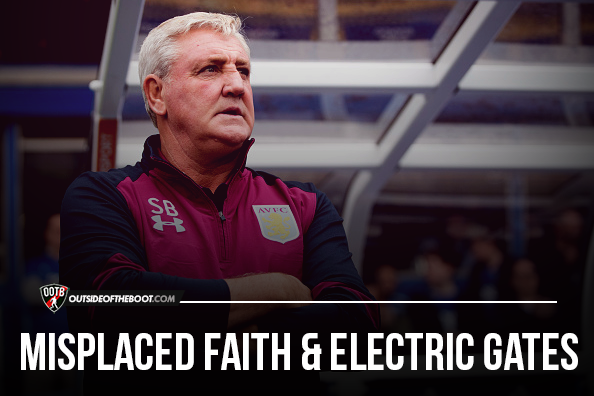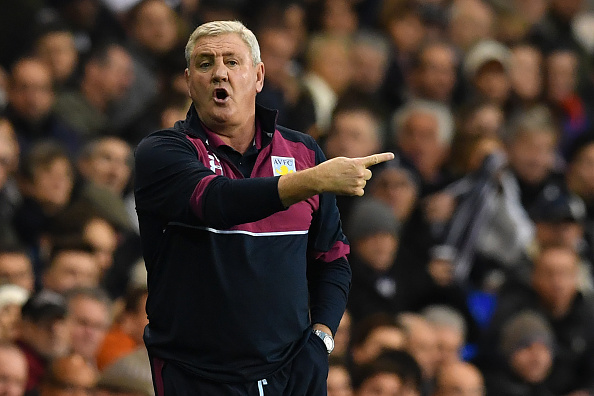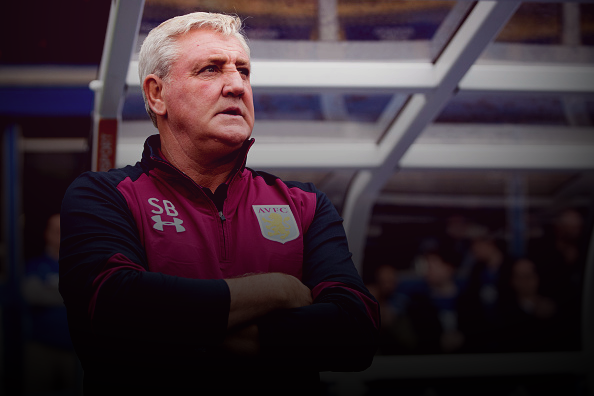Ross Bramble writes about Aston Villa and their time in the Championship so far.
Listen to the English media, and it’s sometimes easy to forget that there exists a life beneath the Premier League. The top division in English football is so highly vaunted and so widely broadcast that other aspects of the English game seem to be cast aside as pale and uninteresting alternatives. That, however, could not be further from the truth. The Championship especially is one of the most competitive and dynamic story-telling divisions in the world, featuring giants and minnows of English football alike competing at the ends of the table they weren’t expected to be. The Championship also offers restitution for a number of Premier League clubs, whose fans find themselves disconnecting with the money-driven, instant success culture of the top flight.

Amongst the clubs competing in the Championship this season are Aston Villa. The Villains have been a main-stay in the Premier League since its inception in the 1990s, but found themselves battered and torn by years of poor form. Their relegation in the 2015-16 season was a surprise to no-one, and conflicting theories arose as to what the Villains could expect from their time in the second tier. The truth, however, is that life in the Championship has been far from predictable for Aston Villa so far.
The Downfall of the Villains
It’s fair to say that Aston Villa’s 2016 Premier League relegation was a long time in coming. The Villains had been caught in the draining bath water for a number of seasons before they were finally dragged begrudgingly down the plughole. Their 1-0 defeat to Manchester United consigned them to their inevitable demotion, ending a 28-year stay in English football’s top flight. There now only remain 7 founding members of the Premier League yet to be ousted from the top table – and to be honest, Aston Villa’s stay ended less with a bang, and more with a whimper.
Their descent began with the resignation of now Northern Ireland boss Martin O’Neill. The Villains made two trips to Wembley under his charge, qualified for the Europa League and finished 6th in the Premier League for three consecutive seasons. Five days before the opening of the 2010-11 season, however, O’Neill resigned with immediate effect, citing a lack of funds for new recruits. With his resignation came a prolonged period of slow decline for the Villains, with Gerard Houlier, Alex McLeish, Paul Lambert, Tim Sherwood and Remi Garde all unable to bring the claret and blues back to the heady heights of the O’Neill era.
The chairman Randy Lerner was coming under increased scrutiny from Villa fans, too. His appointment of Alex McLeish, the then-manager of fierce local rivals Birmingham City, had been staunchly opposed with protests, banners and chants long before it had been officially announced. Add to that the growing frustration over a lack of significant funding, and Lerner’s time at Villa seemed to be reaching an acrimonious end. He made the club available for purchase in 2012, having announced net losses of £53m. Under Paul Lambert, the Villains were forced to focus their transfer business on the lower leagues. Lambert’s job was made that much harder without a consistent goal scorer, especially when Christian Benteke was sold on to divisional rivals Liverpool. In his final season in charge, the Scotsman only oversaw 12 goals in 25 games – a record divisional low – and was replaced by the more forward-thinking Tim Sherwood.
Unfortunately for Aston Villa, the gambit failed. Sherwood was unable to stop the rot himself, despite seemingly renewed investment from Lerner in a bid to keep the Villains afloat. Remi Garde’s spell in charge was equally lifeless, and ultimately saw the side relegated to the second tier of English football. Widely regarded at the time as one of the worst Premier League teams of the modern era, little can be said in defence of the campaign Aston Villa ran that season – typified of course by Joleon Lescott’s back-pocket butt-Tweet of his swanky new car, in spite of another terrible league performance just hours earlier. Some pundits suggested that, without new ownership, Aston Villa may be settling in for another tough spell for league survival, rather than immediate promotion. Graciously for the Villa, though, new ownership was exactly what they got.
Tony Xia & Roberto Di Matteo
In June 2016, the Chinese business Tony Xia completed a takeover of the seven-time FA Cup winners, with a promise to bring the good times back to Villa Park. The face of the new revolution was to be Roberto Di Matteo, written in to football folklore for his incredible run as Chelsea manager, where he presided over the side’s first Champions League success. The Italian had only managed one club since his London departure – a near season-long spell with German outfit Schalke, which ultimately saw the side miss out on the Champions League after a run of only two wins in the final ten Bundesliga games.
What Aston Villa needed was simple enough – out with the old, in with the new. The baggage the Villains had been carrying for the past five years needed casting off quickly, for the sake of the fans and the club its self. For the first two months, however, they got very little of either. In fact, when the season began on the 5th of August, Aston Villa had only recruited four new players, and sold six. In defence of their business, Tommy Elphick and Ross McCormack were widely regarded as excellent deals for a second tier side looking to rebuild its spine. A spine, however, is not built on two players alone.
Many of the mercenaries hounded so vehemently by the media and the Villa faithful were still in place when their campaign began away to Sheffield Wednesday. That game ended in defeat, and the problems were soon exposed by a 3-1 defeat to League Two minnows Luton Town in the EFL Cup three days later. The team claimed a 3-0 win at home to the league’s whipping boys Rotherham the following weekend, but were unable to win a game again until October 18th – a run of ten games without a win. Their poor start inspired a frantic end to the summer for Aston Villa, adding five new players inside the final two-and-a-half weeks of the transfer window. Another five players were pushed out of Villa Park in that period, too, creating a mess of confusion for Di Matteo. The work of bedding in a new team, with new tactics and new team-mates in a new division, is a job better tackled in the off season, rather than three weeks in to the campaign of a league as frantic as the Championship.

BIRMINGHAM, ENGLAND – AUGUST 16: Manager Roberto di Matteo of Villa looks on during the Sky Bet Championship match between Aston Villa and Huddersfield Town at Villa Park on August 16, 2016 in Birmingham, England. (Photo by Stu Forster/Getty Images)
Di Matteo’s first great mistake was a serious lack of homework. Anyone who had watched Aston Villa the season prior knew that the side were in desperate need of a complete refurbishment. The defence was too leaky and old, the midfield wasn’t creative enough and the strikers weren’t potent enough. Add to that a number of players who were happy just to collect a pay check and do a little jogging during training (at least, that was the perception at the time), and Aston Villa’s squad was a rotten mess. Assuming that he could step in to Aston Villa, keep the better players for a season and come straight back up was a catastrophic example of misplaced faith, which ultimately saw the side slump into the relegation mire, and cost the Italian his job in early October. Di Matteo – and Tony Xia – had both put far too much faith in a team that Paul Lambert, Tim Sherwood and Remi Garde couldn’t make work. Why on Earth would it work now, just because the club were one division lower?
Misplaced Faith & Electric Gates
By the time Steve Bruce was appointed on October 12th, the damage to Aston Villa’s season had been done. The team was bogged in mid-table, the players were frustrated and the dream of a one-season stopover in the Championship seemed all but dead. Bruce himself complained about a lack of fitness, professionalism and effort from his players during training, some of which had carried over from the season prior. This was never more typified than by his explosive and almost unbelievable falling out with Ross McCormack. Bruce accused the Scotland international of being out shape, and the striker was also punished for repeatedly missing training sessions. His excuse? The electric gates at his house were malfunctioning, and he was unable to make it to the training ground. The excuse sounded so flimsy to Steve Bruce that the manager even got in his car, drove to McCormack’s house and judged for himself. His next press conference was almost something from a comedy sketch, when the boss scathingly reporting that “The gate was only four feet six inches. So he couldn’t jump it. And it was raining.”

Aston Villa’s English manager Steve Bruce gestures on the touchline during the English FA Cup third round football match between Tottenham Hotspur and Aston Villa at White Hart Lane in London, on January 8, 2017. / AFP / Ben STANSALL / RESTRICTED TO EDITORIAL USE. No use with unauthorized audio, video, data, fixture lists, club/league logos or ‘live’ services. Online in-match use limited to 75 images, no video emulation. No use in betting, games or single club/league/player publications. / (Photo credit should read BEN STANSALL/AFP/Getty Images)
In spite of his clear frustration with the issues he was dealing with backstage, the January window provided Steve Bruce with a fantastic platform to do the sort of business Aston Villa had been crying out for back in the summer. Sam Johnstone, Birkir Bjarnasson, Henri Lansbury, Scott Hogan, Neil Taylor, Conor Hourihane and James Bree represent the wholesale changes the Villains required four months prior. Seven players were shipped in the opposite direction – including a loan deal for McCormack, putting an end to gate-gate for now at least. Despite doing excellent and much-needed business in January, Aston Villa are now back in the same place they were under Di Matteo; wholesale changes that should have been made in July have instead had to be done mid-season, and once again, the club is being punished for it. The Villains are yet to win a league game in 2017, collecting only one point from a possible eighteen.
It doesn’t seem likely that Steve Bruce will head the same way as Roberto Di Matteo. Tony Xia, so far at least, has come across as a level headed chairman, willing to accept his mistakes and learn from those whose knowledge of the game exceeds his own. Villa fans, too, seem to still believe that Bruce is the man for the job, and the blame has fallen more so on the players and the current re-adjustment. Their playoff hopes, which seemed a little more tangible during the beginning of Bruce’s run, seem to be fading back in to the blackness again. The threat of relegation exists, but certainly isn’t a possibility being humoured by many on-lookers. All that being said, Aston Villa are showing signs of a team that will be dangerous challengers for the promotion places next season. With a rejuvenated core now in place and learning the Steve Bruce way, Villa will have half a season to continue to develop an understanding beside their new teammates, which will benefit them immensely next season.
The Aston Villa story has been an unpredictable, miserable ride for many of those in claret and blue. Tony Xia’s ownership heralds the dawn of a new era for the club, and in spite of putting a lot of faith in the wrong players and managers, that dawn is just sneakily beginning to break. Steve Bruce’s new-look Villains are in for a rocky end to their season, but with the regeneration of Aston Villa finally set down in the January transfer window, Villa fans can finally start to believe in what the future holds. Misplaced faith and electric gates have set the Aston Villa project back a season, but there’s every reason to believe that the project is back on the right track.
- Tactical Philosophy: Domenico Tedesco - September 25, 2018
- Bilic, Gold & Sullivan: Which is the West Ham Way? - September 11, 2017
- Southampton: The Claude Puel Chronicles - July 10, 2017
























































